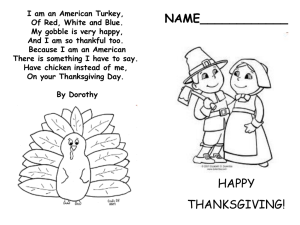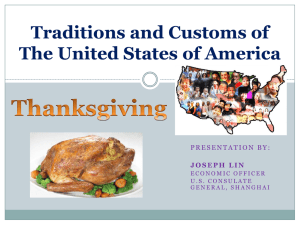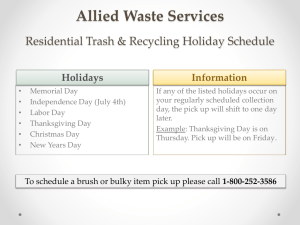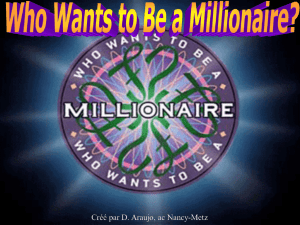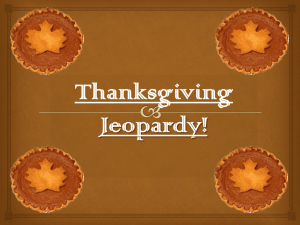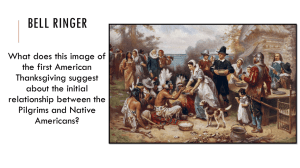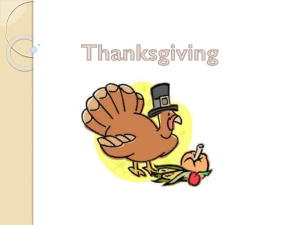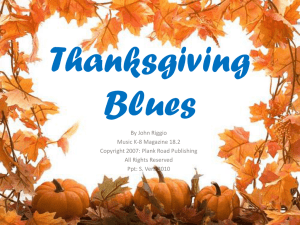Should the First Thanksgiving be remembered as a day of
advertisement
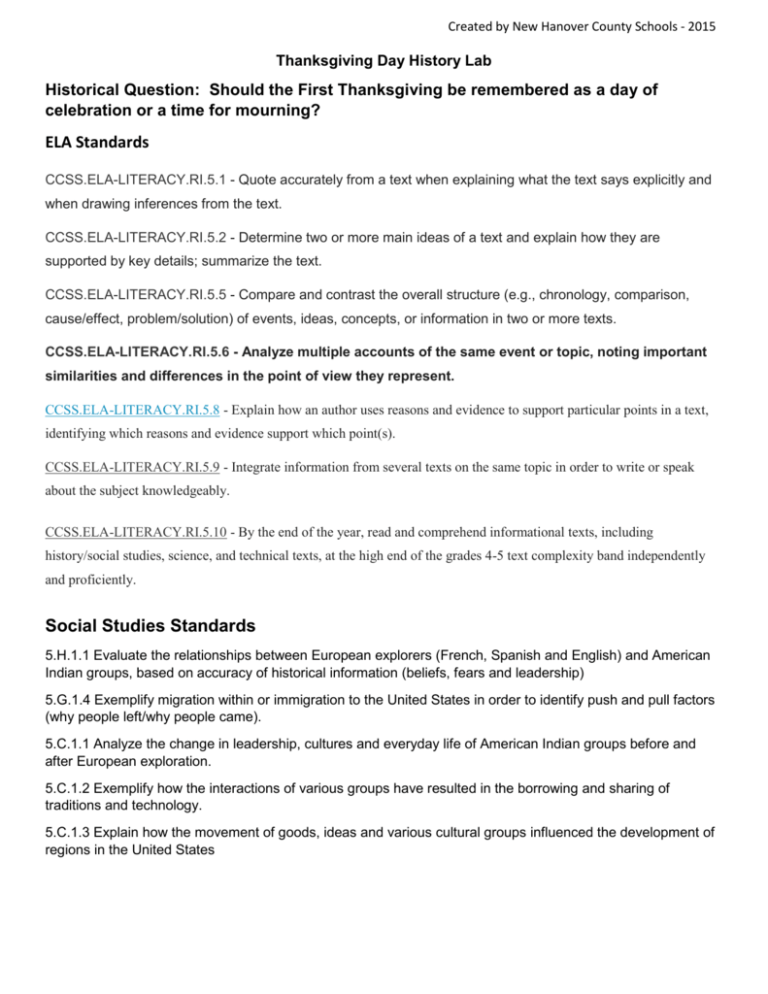
Created by New Hanover County Schools - 2015 Thanksgiving Day History Lab Historical Question: Should the First Thanksgiving be remembered as a day of celebration or a time for mourning? ELA Standards CCSS.ELA-LITERACY.RI.5.1 - Quote accurately from a text when explaining what the text says explicitly and when drawing inferences from the text. CCSS.ELA-LITERACY.RI.5.2 - Determine two or more main ideas of a text and explain how they are supported by key details; summarize the text. CCSS.ELA-LITERACY.RI.5.5 - Compare and contrast the overall structure (e.g., chronology, comparison, cause/effect, problem/solution) of events, ideas, concepts, or information in two or more texts. CCSS.ELA-LITERACY.RI.5.6 - Analyze multiple accounts of the same event or topic, noting important similarities and differences in the point of view they represent. CCSS.ELA-LITERACY.RI.5.8 - Explain how an author uses reasons and evidence to support particular points in a text, identifying which reasons and evidence support which point(s). CCSS.ELA-LITERACY.RI.5.9 - Integrate information from several texts on the same topic in order to write or speak about the subject knowledgeably. CCSS.ELA-LITERACY.RI.5.10 - By the end of the year, read and comprehend informational texts, including history/social studies, science, and technical texts, at the high end of the grades 4-5 text complexity band independently and proficiently. Social Studies Standards 5.H.1.1 Evaluate the relationships between European explorers (French, Spanish and English) and American Indian groups, based on accuracy of historical information (beliefs, fears and leadership) 5.G.1.4 Exemplify migration within or immigration to the United States in order to identify push and pull factors (why people left/why people came). 5.C.1.1 Analyze the change in leadership, cultures and everyday life of American Indian groups before and after European exploration. 5.C.1.2 Exemplify how the interactions of various groups have resulted in the borrowing and sharing of traditions and technology. 5.C.1.3 Explain how the movement of goods, ideas and various cultural groups influenced the development of regions in the United States Created by New Hanover County Schools - 2015 Source 1: The Story of the First Thanksgiving In 1620, the Mayflower landed at the place that is now Massachusetts. There were 101 Pilgrims aboard the ship. After some time, the Pilgrims built a town called Plymouth. The Pilgrims landed near the area where the Wampanoag (wahmpah-NOH-ahg) people already lived. The Wampanoag people knew how to stay safe during cold winters. They made homes called wetus (weh-TOOZ) to protect themselves from the cold. They also made warm clothing from deerskin. The Pilgrims arrived close to wintertime. That winter was very cold, and many Pilgrims died. When spring came, the Pilgrims did not know where to get food. A Wampanoag man named Squanto helped the Pilgrims. He showed them where to hunt, and he taught them how to grow corn. This helped the Pilgrims get food to eat. When the fall harvest came, the Pilgrims had plenty of food to eat! They were very thankful for Squanto's help. Together, the Pilgrims and the Wampanoag people had a harvest celebration. For three days people ate, played games, and told stories to celebrate and give thanks. That harvest celebration helped start the American tradition of Thanksgiving. Today, people still share food with their families and friends on this holiday. People also play games, tell stories, and spend time together to show they are thankful. Many people travel to be together on Thanksgiving, too. Source: 2004 ReadWorks.org (written by Weekly Reader Corporation) Created by New Hanover County Schools - 2015 Source 2: Thanksgiving Day Image Source: This image came from City View magazine – a weekly magazine based in Iowa. The image was directly associated with an article about how many Native Americans disagree with the celebration of the Thanksgiving holiday. Here is the link to the image and article: http://www.dmcityview.com/2009/11/26/features/ Created by New Hanover County Schools - 2015 Source 3: This painting by J.L.G Ferris, titled The First Thanksgiving 1621, was published in 1932. Created by New Hanover County Schools - 2015 Source 4: Official National Day of Mourning Marker – This historical marker helps to serve the United American Indians of New England (they meet every year on Thanksgiving Day to mourn what they believe was the start of a genocide of Native American culture). Exact date for historical marker creation not given. Created by New Hanover County Schools - 2015 Source 5: Fictional story centered on an invitation to a Wampanoag Native American Tribe member received for the Plymouth, Massachusetts Thanksgiving celebration. Setting: 1921, Plymouth, Massachusetts: 300 years after the first colonial Thanksgiving that took place in Plymouth, Massachusetts between the Pilgrims and members of the Wampanoag Native American tribe. People have gathered to celebrate and remember. Mayor: “Good afternoon again. For those of you that were not here earlier, my name is Jon Waugh and I am the current mayor of Plymouth, Massachusetts. As you know, we are celebrating the 300 thyear anniversary of the first Thanksgiving in America – a time where Native Americans and settlers feasted, played, ate, drank, laughed, and generally enjoyed the company of others.” “Though the Pilgrims were British citizens, Thanksgiving would go on to become a great American tradition that the entire country looks forward to every year. “ “So, thank you again for coming out today – I know the weather is a little grey and a bit chilly, but this is truly one of the most historic moments in our nation’s history.” “With that said, we now have a special treat. It is my pleaser to introduce a man named Doba, who is an actual descendant (family member) of the Wampanoag Indian tribe. He is going to give us a few words about what this great celebration means to him and his family. With that, I give you Doba (loud clapping from the audience).” Doba: “Hello – thank you for having me. I appreciate Mayor Waugh reaching out to our people to have a part in the historic day. Though I am Wampanoag, I have grown up in the United States. I know the story of the first Thanksgiving. The Pilgrims had almost starved during their first winter here in 1620. By 1621, the Pilgrims had settled in – thanks to the help of Squanto and other Wampanoag natives.” “After all, our people showed the Pilgrims what types of foods they could grow, how to farm in this part of the world, and how to hunt and how to build homes that would last through the winter. Due to this stabilization, a call was given to celebrate and Pilgrims and Natives got together and did just that for three days. No doubt it was fun and amazing.” “However, you need to know something else. Our people now consider your first Thanksgiving a grave tragedy. For us, it is not a time for remembrance or celebration. The story we are telling is only partly true. Yes Native and Whites ate together and enjoyed each other for three days…but the party soon ended for my people and let me tell you what happened.” “The truth is, many whites in Plymouth, who would have starved without my ancestors, forgot the kindness that was given to them by my people. More whites came over to Massachusetts and they wanted more land. These new whites saw our people as savages that must be moved out or killed. The whites that did remember our kindness did nothing to help us as our lands and freedom were being taken away. In 40 short years, the Wampanoag tribe would no longer exist. I am one of only a handful of blood relatives left.” Created by New Hanover County Schools - 2015 “While you celebrate today out in the cold – please know Native Americans of every tribe see this celebration as the beginning of the end of our culture, tribe, and people. This is not a day that makes us happy and I don’t think any of you fully realize that.” “Thanksgiving was a great three days between my people and the Pilgrims of Plymouth. But when the feast was over, our time in the place started ticking away. I mean none of you any harm…please continue to celebrate, but please understand why I will not be fully joining you. This celebration hurts and I just wanted you all to understand. Thank you (Doba leaves to mostly silence and stunned faces).” Source: Written by the New Hanover County Schools Instructional Services Department - 2015 Created by New Hanover County Schools - 2015 Document Source Analysis Sheet Source or Text Source 1: The Story of the First Thanksgiving Source 2: Thanks For Nothing Image Source 3: The First Thanksgiving Painting Source 4: National Day of Mourning Marker Source 5: Fictional Story of a Wampanoag Native American speaking at Plymouth, MA What do you see (what did you see at first and what do you see after reading or viewing this source again)? Why do you think somebody created this source? Support or Challenge the traditional story of Thanksgiving Created by New Hanover County Schools - 2015 Document Source Analysis Sheet Source or Text Source 1: The Story of the First Thanksgiving Source 2: Thanks For Nothing Image Source 3: The First Thanksgiving Painting Source 4: National Day of Mourning Marker Source 5: Fictional Story of a Wampanoag Native American speaking at Plymouth, MA Who created this piece, when was it created, and what point was the creator trying to get readers to understand? What was implied by the creator and what information may have been left out or not considered? Support or Challenge the traditional story of Thanksgiving Created by New Hanover County Schools - 2015
